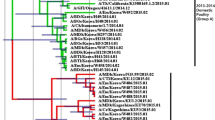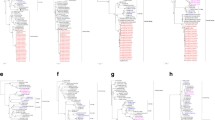Abstract
Among 16 haemagglutinin (HA) subtypes of avian influenza viruses (AIVs), H13 AIVs have rarely been isolated in wild waterfowl. H13 AIVs cause asymptomatic infection and are maintained mainly in gull and tern populations; however, the recorded antigenic information relating to the viruses has been limited. In this study, 2 H13 AIVs, A/duck/Hokkaido/W345/2012 (H13N2) and A/duck/Hokkaido/WZ68/2012 (H13N2), isolated from the same area in the same year in our surveillance, were genetically and antigenically analyzed with 10 representative H13 strains including a prototype strain, A/gull/Maryland/704/1977 (H13N6). The HA genes of H13 AIVs were phylogenetically divided into 3 groups (I, II, and III). A/duck/Hokkaido/W345/2012 (H13N2) was genetically classified into Group III. This virus was distinct from a prototype strain, A/gull/Maryland/704/1977 (H13N6), and the virus, A/duck/Hokkaido/WZ68/2012 (H13N2), both belonging to Group I. Antigenic analysis indicated that the viruses of Group I were antigenically closely related to those of Group II, but distinct from those of Group III, including A/duck/Hokkaido/W345/2012 (H13N2). In summary, our study indicates that H13 AIVs have undergone antigenic diversification in nature.


Similar content being viewed by others
References
B. Olsen, V.J. Munster, A. Wallensten, J. Waldenström, A.D. Osterhaus, R.A. Fouchier, Science (2006).https://doi.org/10.1126/science.1122438
S. Van Borm, T. Rosseel, D. Vangeluwe, F. Vandenbussche, T. van den Berg, B. Lambrecht, Arch Virol. (2012) https://doi.org/10.1007/s00705-012-1323-x
E. Lindh, C. Ek-Kommonen, M. Isomursu, J. Alasaari, A. Vaheri, O. Vapalahti, A. Huovilainen, J. Wildl. Dis. (2017). https://doi.org/10.7589/2016-09-212
D.J. Prosser, C.L. Densmore, L.J. Hindman, D.D. Iwanowicz, C.A. Ottinger, L.R. Iwanowicz, C.P. Driscoll, J.L. Nagel, Avian Dis. (2017). https://doi.org/10.1637/11476-072616-ResNote
J.H. Verhagen, U. Höfle, G. van Amerongen, M. van de Bildt, F. Majoor, R.A. Fouchier, T. Kuiken, J Virol. (2015). https://doi.org/10.1128/JVI.01765-15
D.E. Stallknecht, J.D. Brown, in Avian Influenza, ed. by D.E. Swayne. (Wiley-Blackwell, Hoboken, 2008), pp. 43–58
T. Hiono, A. Ohkawara, K. Ogasawara, M. Okamatsu, T. Tamura, D.H. Chu, M. Suzuki, S. Kuribayashi, S. Shichinohe, A. Takada, H. Ogawa, R. Yoshida, H. Miyamoto, N. Nao, W. Furuyama, J. Maruyama, N. Eguchi, G. Ulziibat, B. Enkhbold, M. Shatar, T. Jargalsaikhan, S. Byambadorj, B. Damdinjav, Y. Sakoda, H. Kida, Virus Genes. (2015) https://doi.org/10.1007/s11262-015-1214-9
Y. Sakoda, H. Ito, Y. Uchida, M. Okamatsu, N. Yamamoto, K. Soda, N. Nomura, S. Kuribayashi, S. Shichinohe, Y. Sunden, T. Umemura, T. Usui, H. Ozaki, T. Yamaguchi, T. Murase, T. Ito, T. Saito, A. Takada, H. Kida, J. Gen. Virol. (2012). https://doi.org/10.1099/vir.0.037572-0
V.S. Hinshaw, G.M. Air, A.J. Gibbs, L. Graves, B. Prescott, D. Karunakaran, J. Virol. 42, 865–872 (1982)
J. Brown, R. Poulson, D. Carter, C. Lebarbenchon, M. Pantin-Jackwood, E. Spackman, E. Shepherd, M. Killian, D. Stallknecht, Avian Dis. (2012) https://doi.org/10.1637/10158-040912-Reg.1
H.M. Kang, J.G. Choi, M.C. Kim, H.R. Kim, J.K. Oem, Y.C. Bae, M.R. Paek, J.H. Kwon, Y.J. Lee, Virol J. (2012). https://doi.org/10.1186/1743-422X-9-133
R. Velarde, S.E. Calvin, D. Ojkic, I.K. Barker, É Nagy, Avian Dis. (2010). https://doi.org/10.1637/8808-040109-Reg.1
Y. Tsuda, N. Isoda, Y. Sakoda, H. Kida, Virus Res. (2009).https://doi.org/10.1016/j.virusres.2008.12.005
J.C. Obenauer, J. Denson, P.K. Mehta, X. Su, S. Mukatira, D.B. Finkelstein, X. Xu, J. Wang, J. Ma, Y. Fan, K.M. Rakestraw, R.G. Webster, E. Hoffmann, S. Krauss, J. Zheng, Z. Zhang, C.W. Naeve, Science. (2006). https://doi.org/10.1126/science.1121586
World Organization for Animal Health (2017) Chap. 2.3.4. Avian influenza. In Manual of Diagnostic Tests and Vaccines for Terrestrial Animals 2017, http://www.oie.int/en/international-standard-setting/terrestrial-manual/access-online/. Accessed 25 April 2018
D.H. Chu, M. Okamatsu, K. Matsuno, T. Hiono, K. Ogasawara, L.T. Nguyen, L. Van Nguyen, T.N. Nguyen, T.T. Nguyen, D. Van Pham, D.H. Nguyen, T.D. Nguyen, T.L. To, H. Van Nguyen, H. Kida, Y. Sakoda, Vet. Microbiol. (2016). https://doi.org/10.1016/j.vetmic.2016.07.016
M.A. Larkin, G. Blackshields, N.P. Brown, R. Chenna, P.A. Mcgettigan, H. Mc William, F. Valentin, I.M. Wallace, A. Wilm, R. Lopez, J.D. Thompson, T.J. Gibson, D.G. Higgins, Bioinformatics. (2007) https://doi.org/10.1093/bioinformatics/btm404
K. Tamura, G. Stecher, D. Peterson, A. Filipski, S. Kumar, Mol. Biol. Evol. (2013) https://doi.org/10.1093/molbev/mst197
I.A. Wilson, J.J. Skehel, D.C. Wiley, Nature 289, 366–373 (1981)
X. Lu, J. Qi, Y. Shi, M. Wang, D.F. Smith, J. Heimburg-Molinaro, Y. Zhang, J.C. Paulson, H. Xiao, G.F. Gao, J. Virol. (2013). https://doi.org/10.1128/JVI.00235-13
S. Shichinohe, M. Okamatsu, N. Yamamoto, Y. Noda, Y. Nomoto, T. Honda, N. Takikawa, Y. Sakoda, H. Kida, Vet. Microbiol. (2013) https://doi.org/10.1016/j.vetmic.2013.01.041
J. Dong, H. Bo, Y. Zhang, L. Dong, S. Zou, W. Huang, J. Liu, D. Wang, Y. Shu, Virol. J. (2017). https://doi.org/10.1186/s12985-017-0842-1
A.M. Ramey, J.M. Pearce, C.R. Ely, L.M. Guy, D.B. Irons, D.V. Derksen, H.S. Ip, Virology (2010). https://doi.org/10.1016/j.virol.2010.07.031
J.M. Pearce, A.B. Reeves, A.M. Ramey, J.W. Hupp, H.S. Ip, M. Bertram, M.J. Petrula, B.D. Scotton, K.A. Trust, B.W. Meixell, J.A. Runstadler, Mol. Ecol. (2011). https://doi.org/10.1111/j.1365-294X.2010.04908.x
T.M. Chambers, S. Yamnikova, Y. Kawaoka, D.K. Lvov, R.G. Webster, Virology. (1989). https://doi.org/10.1016/0042-6822(89)90119-0
D.J. Smith, A.S. Lapedes, J.C. de Jong, T.M. Bestebroer, G.F. Rimmelzwaan, A.D. Osterhaus, R.A. Fouchier, Science. (2004). https://doi.org/10.1126/science.1097211
Acknowledgements
We wish to acknowledge Dr. Koichi Otsuki, Tottori University, who kindly provided the A/whistling swan/Shimane/1343/1981 (H13N6) virus. We thank Prof. Ayato Takada for sampling of duck feces and isolation of the A/duck/Hokkaido/WZ68/2012 (H13N2) virus, and Dr. Shintaro Shichinohe for identification of A/duck/Hokkaido/WZ68/2012 strain as H13N2 subtype. This study was partially supported by the Training Program for Asian Veterinarians from the Japan Veterinary Medical Association. This study is also partially supported by the Japan Initiative for Global Research Network on Infectious Diseases (J-GRID) (Grant No. PJ18fm0108008) from the Japan Agency for Medical Research and Development (AMED).
Funding
This study was partially funded by the Training Program for Asian Veterinarians from the Japan Veterinary Medical Association and the Japan Initiative for Global Research Network on Infectious Diseases (J-GRID) (Grant No. PJ18fm0108008) from the Japan Agency for Medical Research and Development (AMED).
Author information
Authors and Affiliations
Contributions
Z-JW wrote this study and performed genetic and antigenic analysis. YK, LTN, TH, SK, RW, and Y-JL performed genetic and antigenic analysis. KM, MO, and HK provided laboratory management support and manuscript editing. YS managed this research project. All authors read and approved the final manuscript.
Corresponding author
Ethics declarations
Conflict of interest
The authors declare no conflict of interest.
Ethical approval
Animal experiments in this study were authorized by the Institutional Animal Care and Use Committee of Hokkaido University (Approval No.: 13-0108), and all experiments were performed according to the guidelines of the committee. All applicable international, national, and/or institutional guidelines for the care and use of animals were followed. The Faculty of Veterinary Medicine, Hokkaido University has had accreditation from the Association for Assessment and Accreditation of Laboratory Animal Care International (AAALAC International) since 2007. This article does not contain any studies with human participants performed by any of the authors.
Additional information
Edited by Keizo Tomonaga.
Electronic supplementary material
Below is the link to the electronic supplementary material.
11262_2018_1573_MOESM1_ESM.pptx
Supplementary Fig. 1—Antigenic cartography of a panel of immune sera against corresponding H13 AIVs. The antigenic cartography was constructed to better understand the antigenic data from the HI test, shown in Table 2, using AntigenMap [26]. The HI test data were used to construct two-dimensional (2D) antigenic map in which the distance between points represents the antigenic distance as measured by a HI test. One unit of antigenic distance on the antigenic map corresponds to a two-fold difference in the serological assay. The web-based software for Antigenic Cartography is available at https://www.antigenic-cartography.org/. (PPTX 76 KB)
11262_2018_1573_MOESM2_ESM.pptx
Supplementary Fig. 2—Amino acid substitutions on a 3-dimensional model of the Group III H13 HA based on H3 numbering. The crystallographic structure of the H13 trimer HA of A/gull/Maryland/704/1977 (H13N6), Protein Databank accession number: 4KPQ [20], is represented. Amino acid substitutions at the antigenic site (based on H3 antigenic sites) are shown in red, and those outside of the antigenic site are shown in blue. (PPTX 226 KB)
Rights and permissions
About this article
Cite this article
Wang, ZJ., Kikutani, Y., Nguyen, L.T. et al. H13 influenza viruses in wild birds have undergone genetic and antigenic diversification in nature. Virus Genes 54, 543–549 (2018). https://doi.org/10.1007/s11262-018-1573-0
Received:
Accepted:
Published:
Issue Date:
DOI: https://doi.org/10.1007/s11262-018-1573-0




